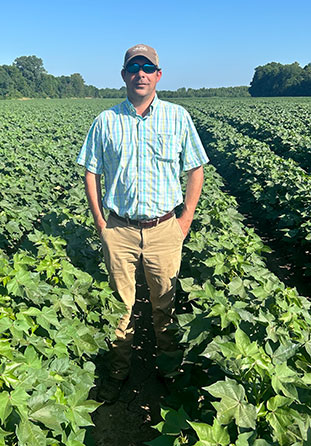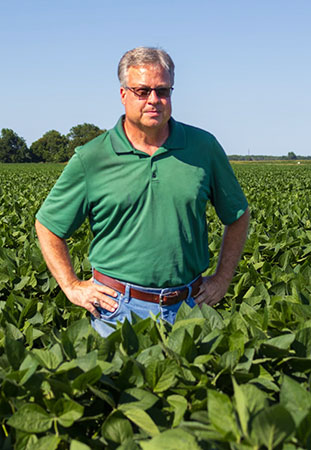DICAMBA QUESTIONS, WEED PRESSURE SPUR INDUSTRY CONVERSATIONS
When Southern farmers look back at the 2024 season, they’re sure to remember the conversations around herbicide systems and weed control.
When Southern farmers look back at the 2024 season, they’re sure to remember the conversations around herbicide systems and weed control.
Questions about the future of in-crop dicamba applications swirled the industry while a wet spring and early summer meant extremely high weed pressure.
The uncertainty highlights the need for producers to take another look at options to control weeds while keeping cotton and soybean yields high. That has led farmers across the South to the benefits of the Enlist® weed control system.

For producer Nathan Lee, the conversation wasn’t a new one. Lee farms cotton, corn, soybeans and rice in Madison and Tensas parishes in northeastern Louisiana. He’s planted PhytoGen® W3FE varieties for years while successfully using the Enlist weed control system to manage weeds and keep fields clean. He first planted PhytoGen® brand varieties for the yield, but he soon found the Enlist system a superior weed control option.
“Enlist One controls pigweeds better than dicamba. When I put the sprayer in the field, I know I’m about to wipe out some weeds,” Lee said. “I can put pigweeds on their nose.”
For applications of Enlist One® herbicide, Lee follows the label and works with his Corteva Agriscience team when he has questions. He’s found that keeping applications on target is possible with Enlist® herbicides.
“If I follow application guidelines, I can spray Enlist One row to row with another crop, and I’ve never had Enlist One get up and move,” Lee said.
If farmers want to incorporate PhytoGen W3FE varieties while also planting dicamba varieties, Lee said, it’s possible to use both the Enlist and dicamba systems. But it requires careful attention and diligence.
“You can plant both technologies, if that’s what someone wants to do. We do it all the time when we plant dicamba soybeans,” Lee said. “You need to take the time to clean the sprayer properly from crop to crop. If you do that and apply according to the label, you will not have a problem.”
Farmers who want to streamline into one system can plant PhytoGen W3FE varieties alongside Pioneer® brand Enlist E3® soybeans and Pioneer® brand PowerCore® Enlist® corn.

Donnie Miller, Ph.D., professor of weed science at the LSU AgCenter Northeast Research Station, has studied the Enlist system for several years, and his research confirms what Lee has seen in the field.
“Enlist One plus glufosinate is one of the better treatments that I have looked at in my research — it is a fantastic tank mix,” Miller said. “The herbicides complement each other well with different modes of action, regardless of the crop they are in — cotton, soybeans and corn.”
Miller said that means using a program approach with residuals and starting clean before planting. He also said weed management is like boxing — you want to knock your opponent down and keep him down.
“You never want to let your opponent off the mat. It’s the same with weeds. You start clean and use a residual at planting. Then you make your first post application with a residual to keep weeds at bay,” Miller said. “You eventually get to a point where your crops are touching shoulders and shade is nature’s residual weed control.”
A program approach helps control weeds in-season and steward technologies for seasons to come. As far as applications, Miller agrees that Enlist herbicides greatly reduce volatility compared with previous 2,4-D formulations, but it’s incumbent on farmers to employ good application principles and follow labels.
“The scientists have done their work to minimize volatility; that’s the first step,” Miller said. “Next, producers need to give their herbicides the best possible chance. The label tells you what to do as far as weed size, rates, water volume, nozzles and weather. If you follow the label, you will minimize physical drift and get the best possible activity on weeds.”
Moving into 2025, Miller says, farmers have more information available to them than ever before, and he encourages them to ask questions, consider their operations and take a look at what’s available.
“Do your research and be open to ideas — that’s how we’re going to keep getting better,” Miller said. “We have a lot of traits and varieties for you to find the right niche for your fields.”
Find information on yield and more in the PhytoGen Cottonseed Agronomy Library.
™ ® Enlist, the Enlist Logo, Enlist One, PhytoGen, and the PhytoGen Logo are trademarks of Corteva Agriscience and its affiliated companies. Enlist Duo® and Enlist One® herbicides are not registered for sale or use in all states or counties. Contact your state pesticide regulatory agency to determine if a product is registered for sale or use in your area. Enlist Duo and Enlist One are the only 2,4-D products authorized for use with Enlist® crops. Consult Enlist® herbicide labels for weed species controlled.
Roundup® and Roundup Ready® are trademarks of Bayer Group. ALWAYS READ AND FOLLOW PESTICIDE LABEL DIRECTIONS. Roundup Ready® technology contains genes that confer tolerance to glyphosate, an active ingredient in Roundup® brand agricultural herbicides. Agricultural herbicides containing glyphosate will kill crops that are not tolerant to glyphosate. ©2024 Corteva. COR (08/24)